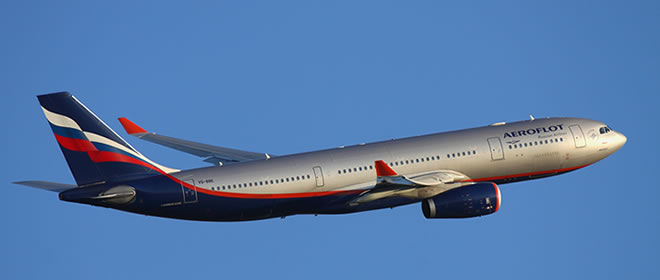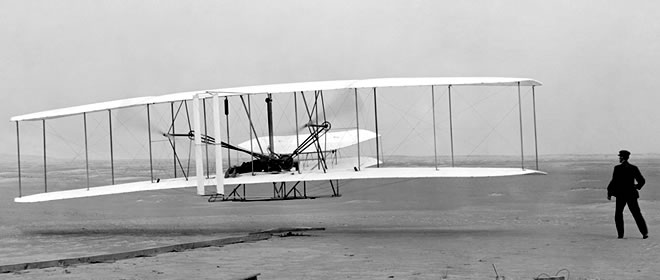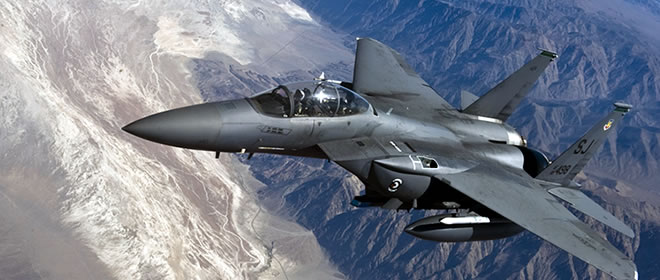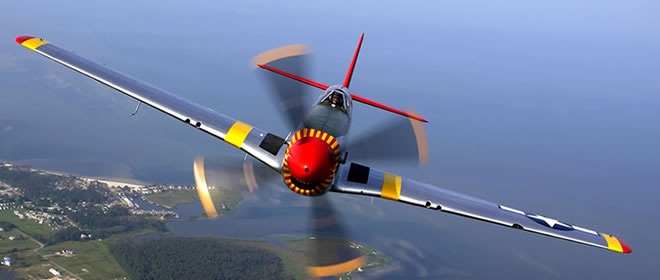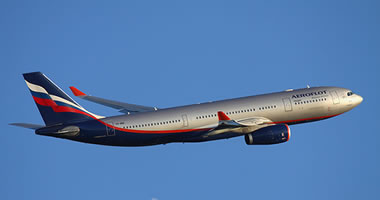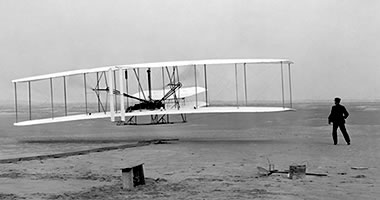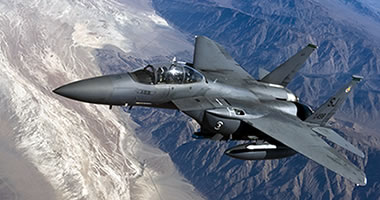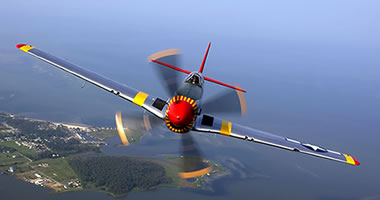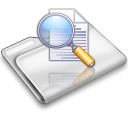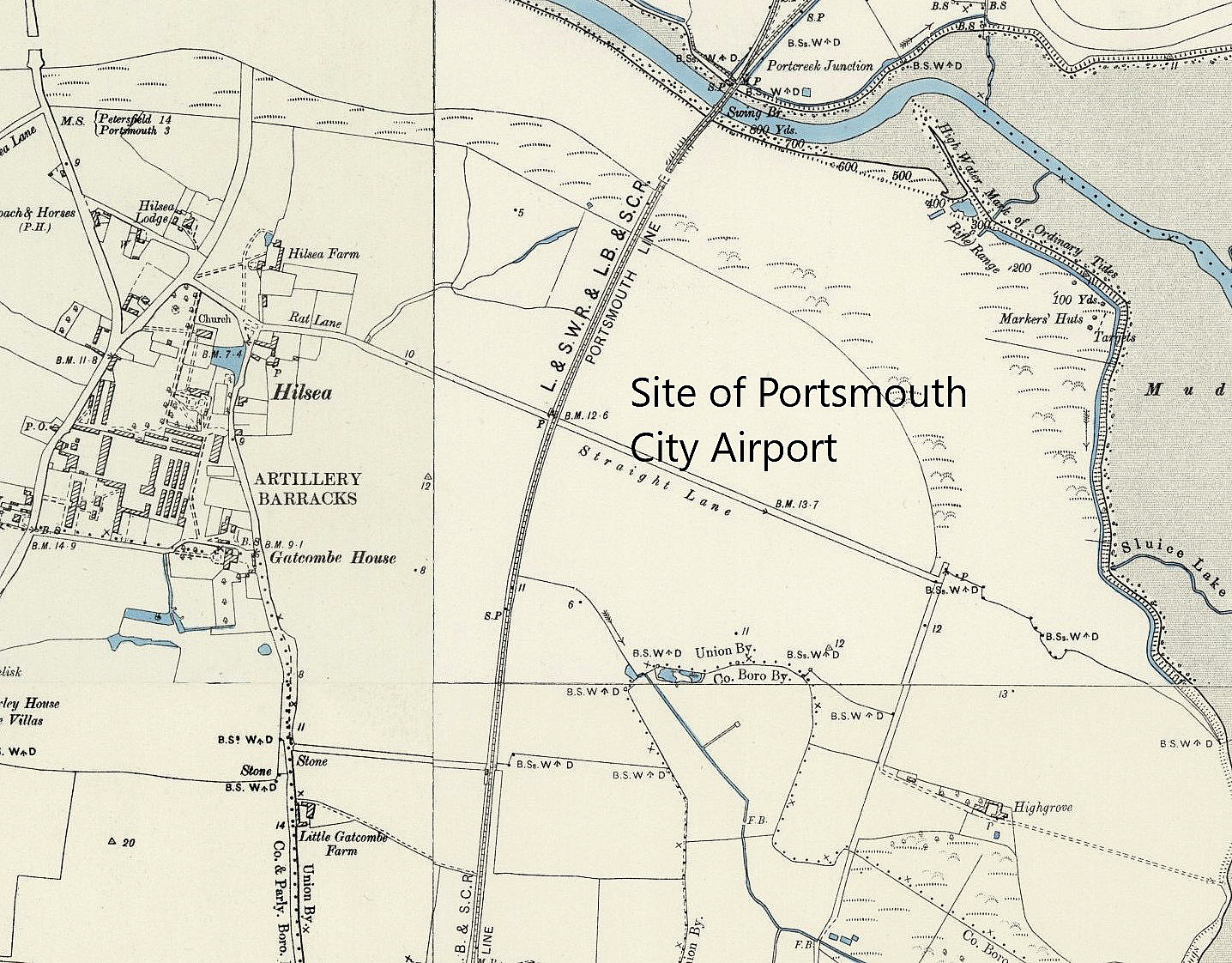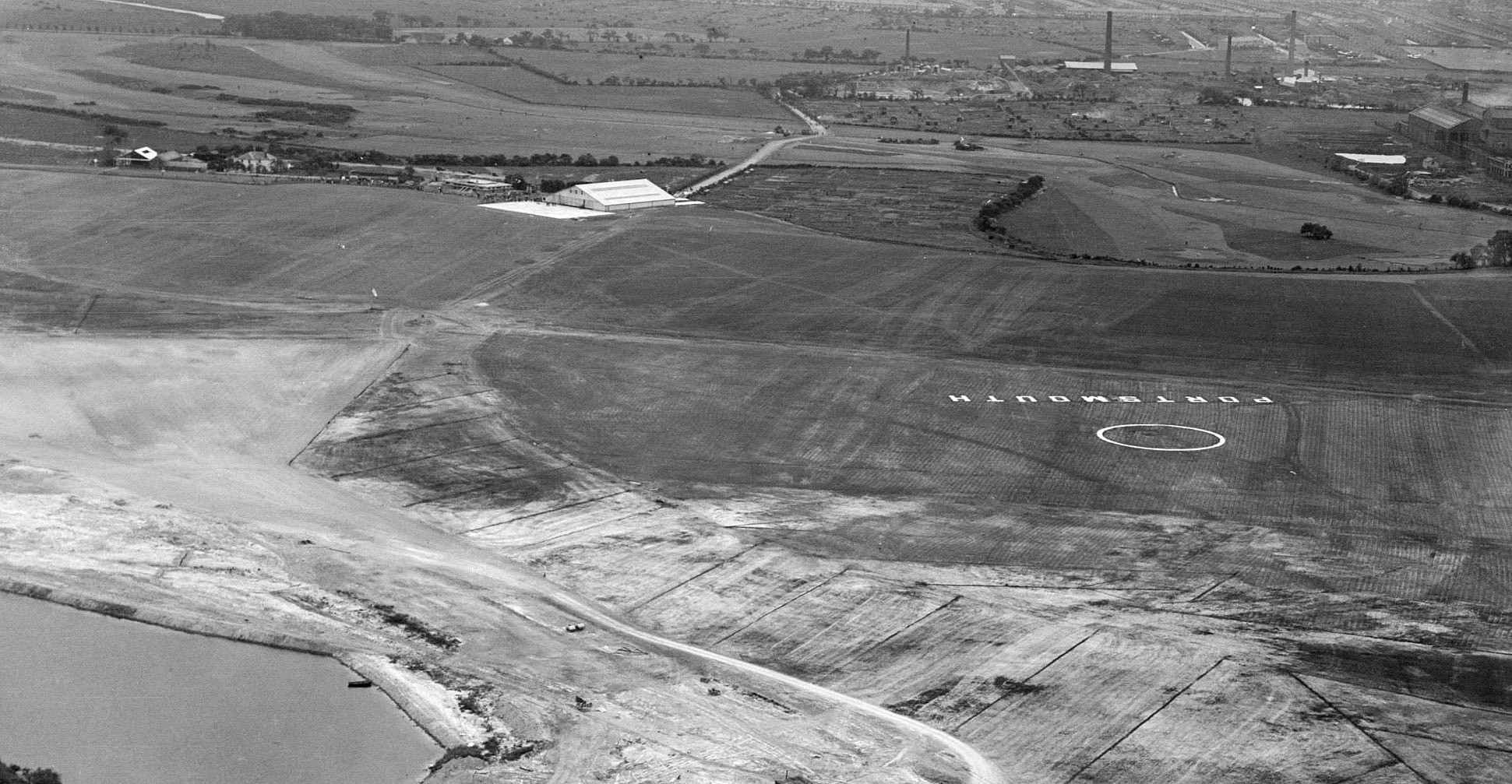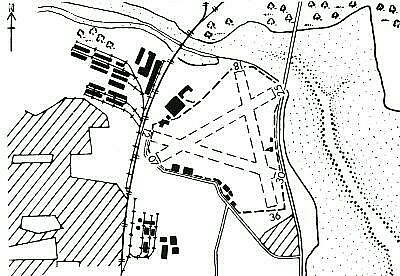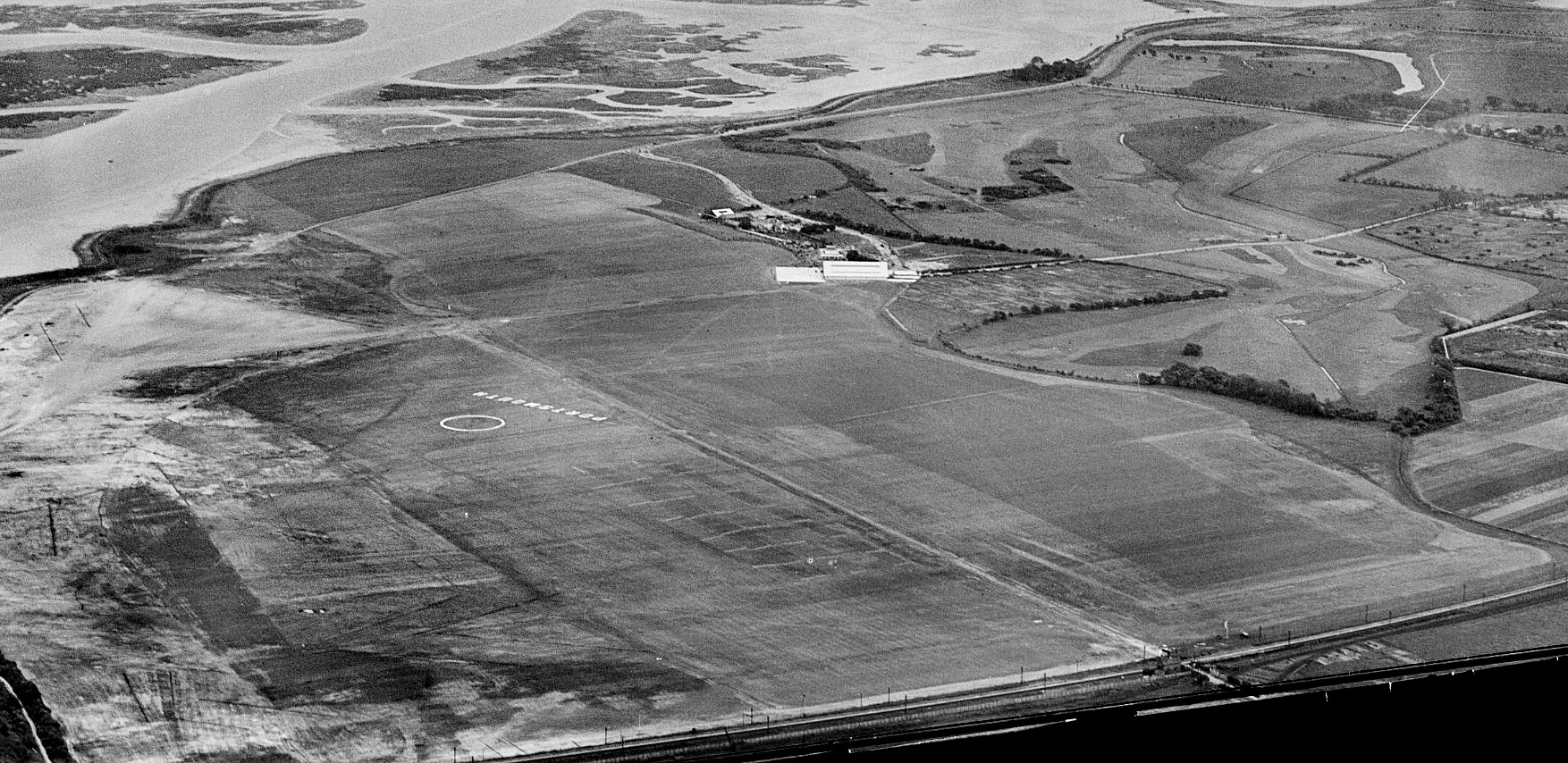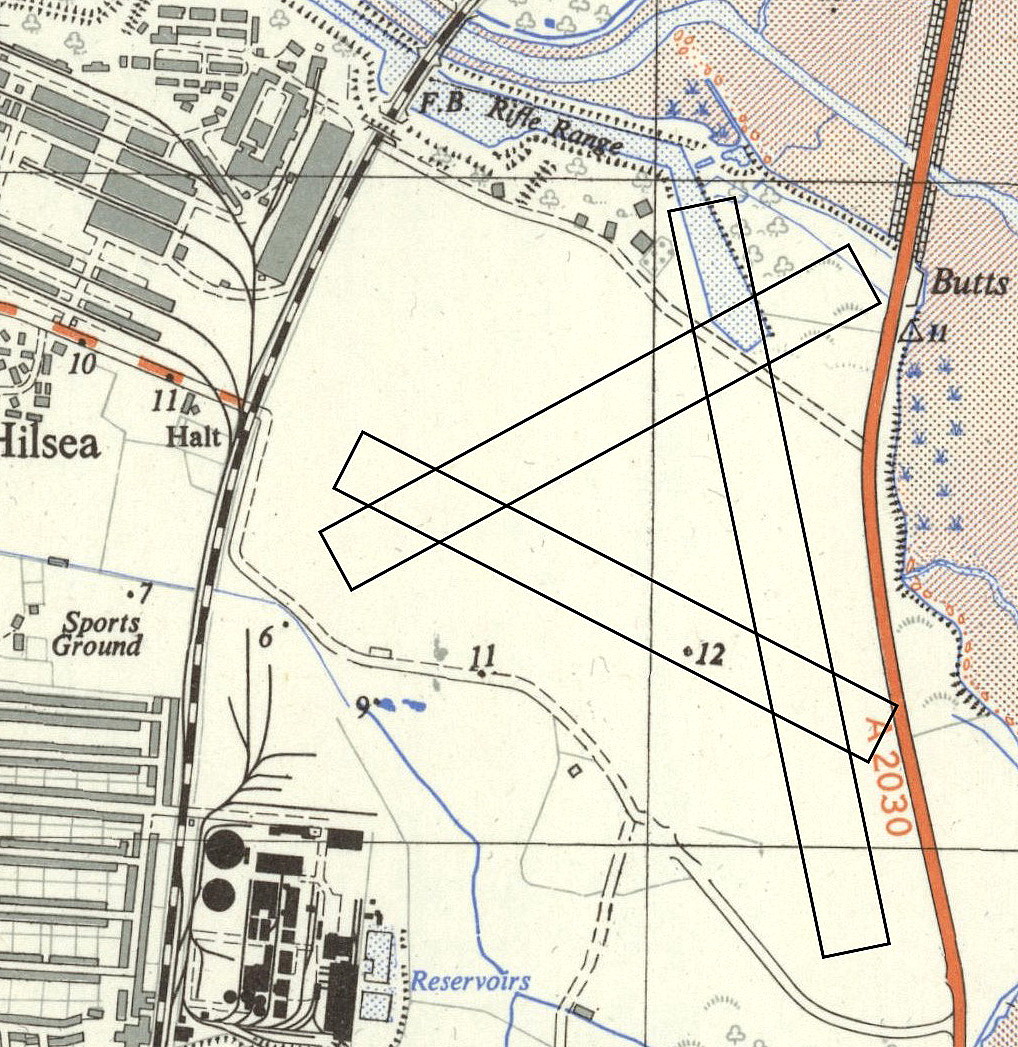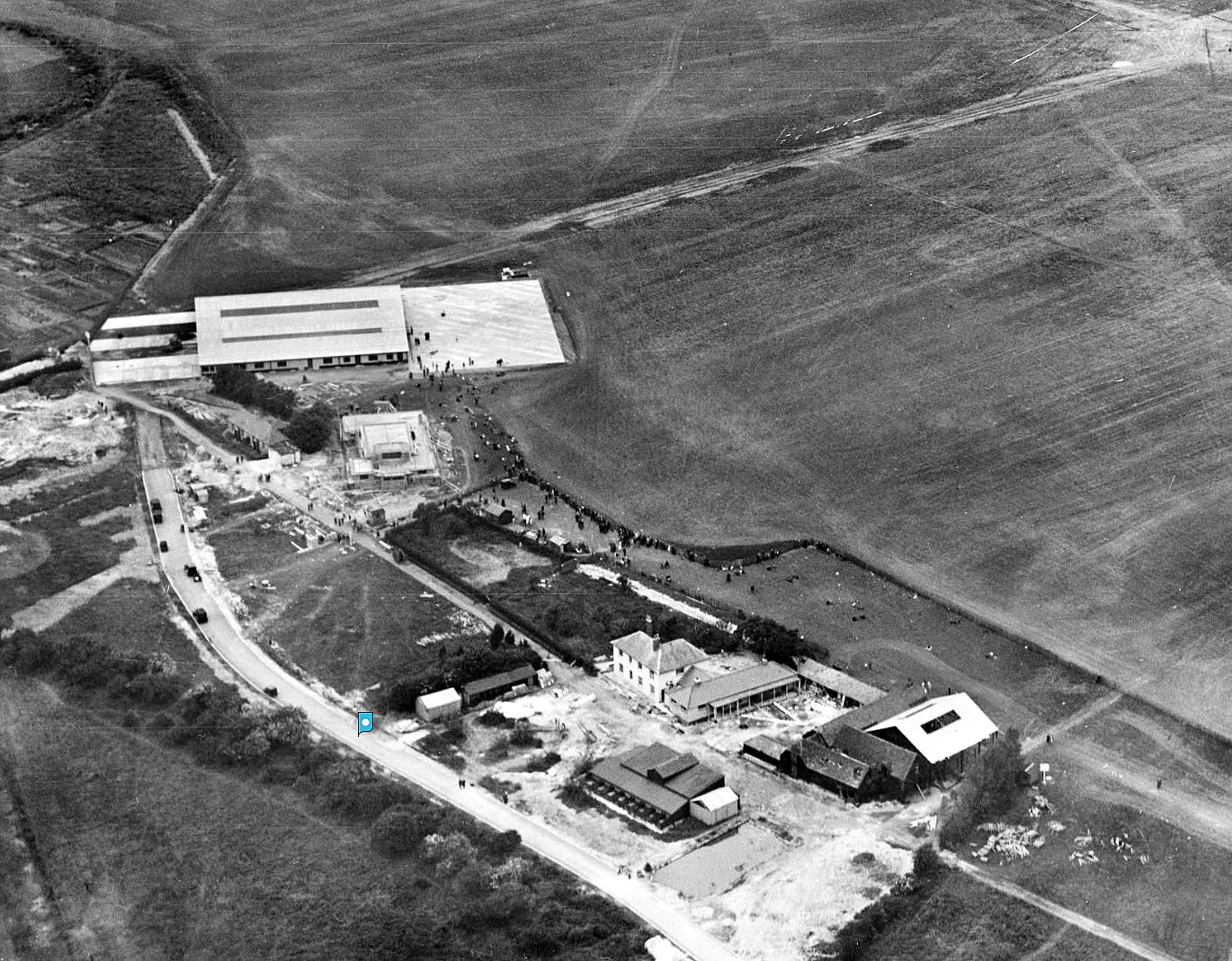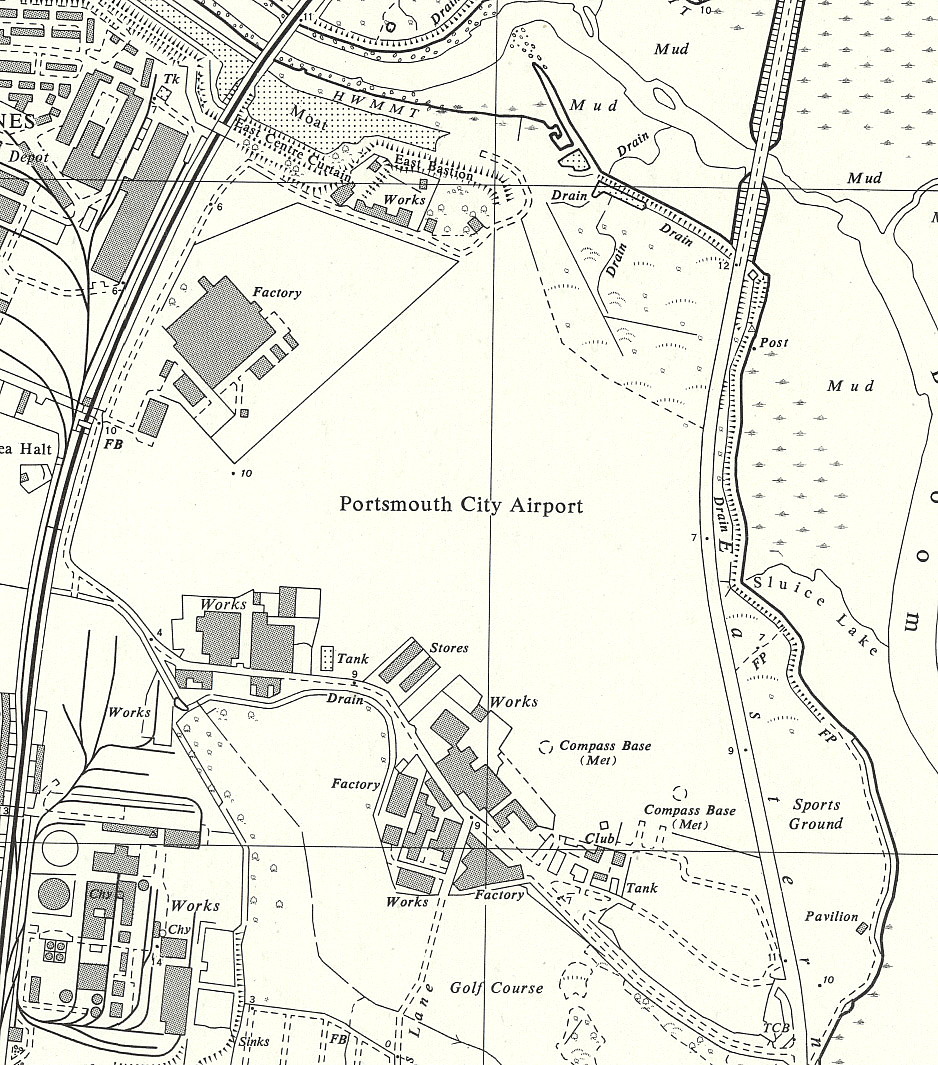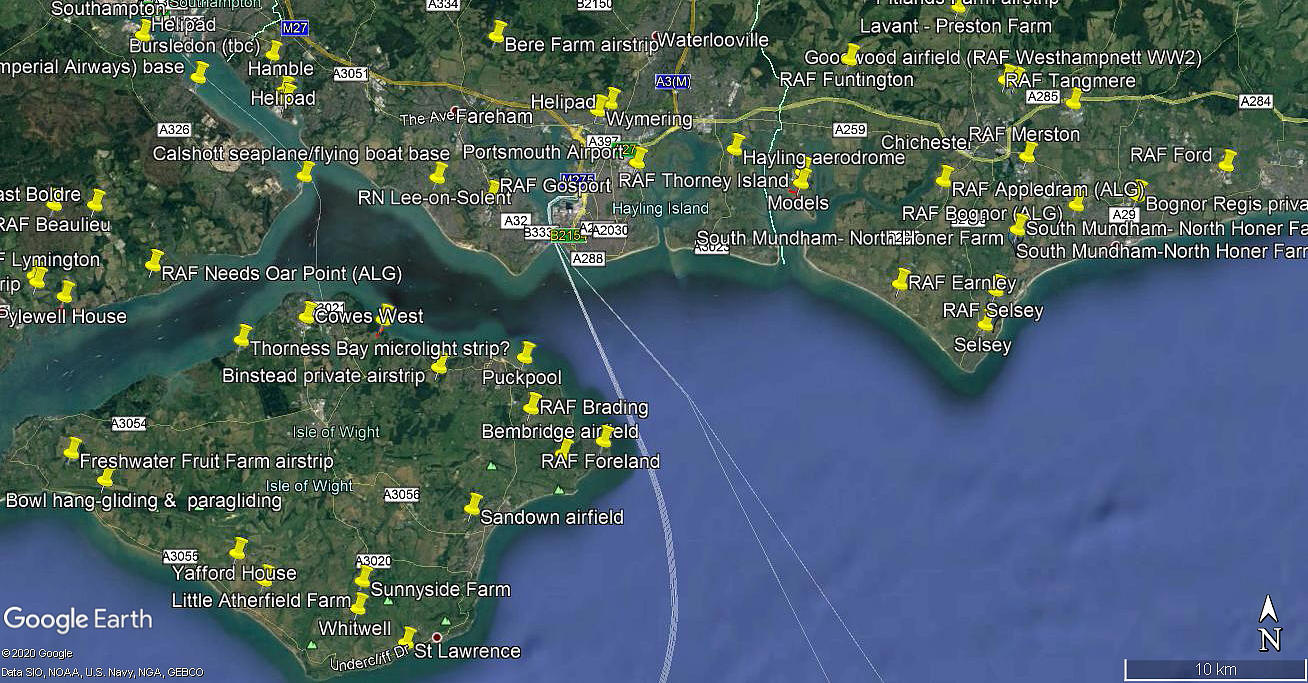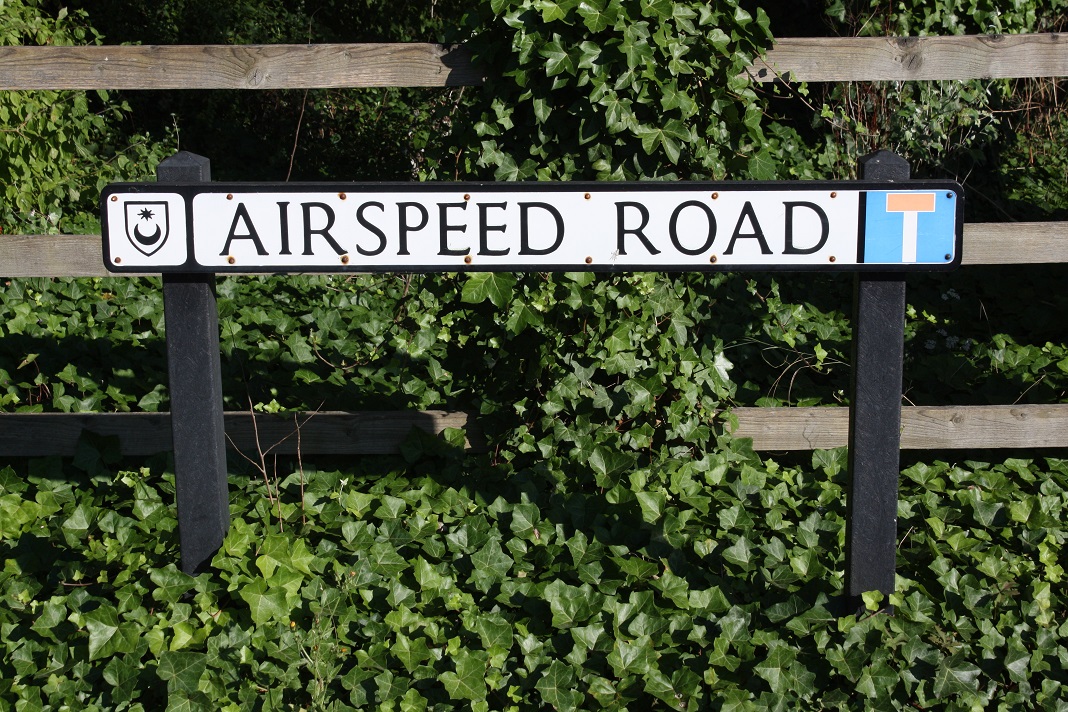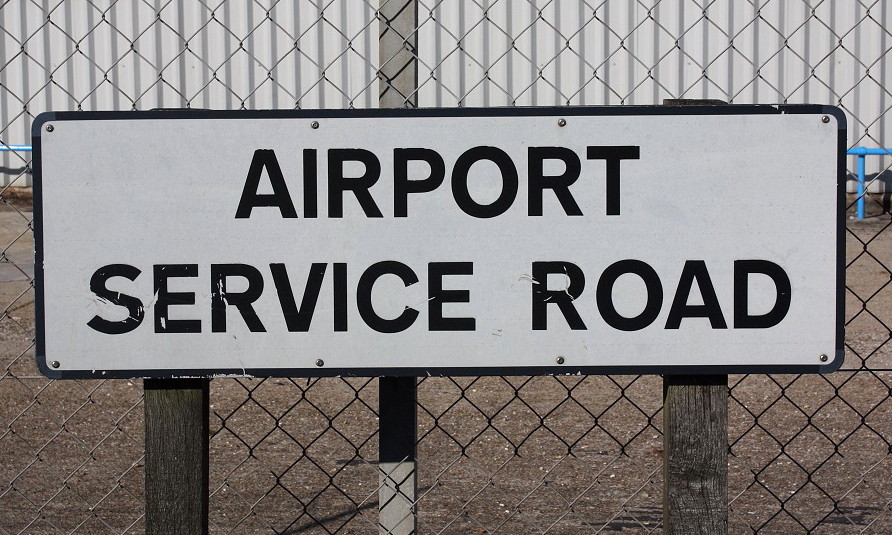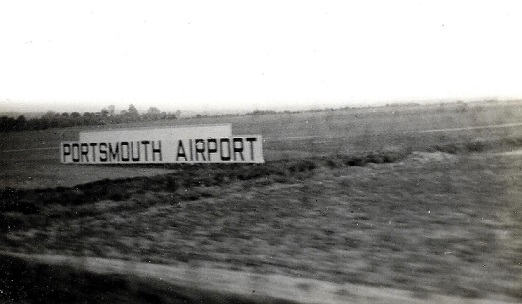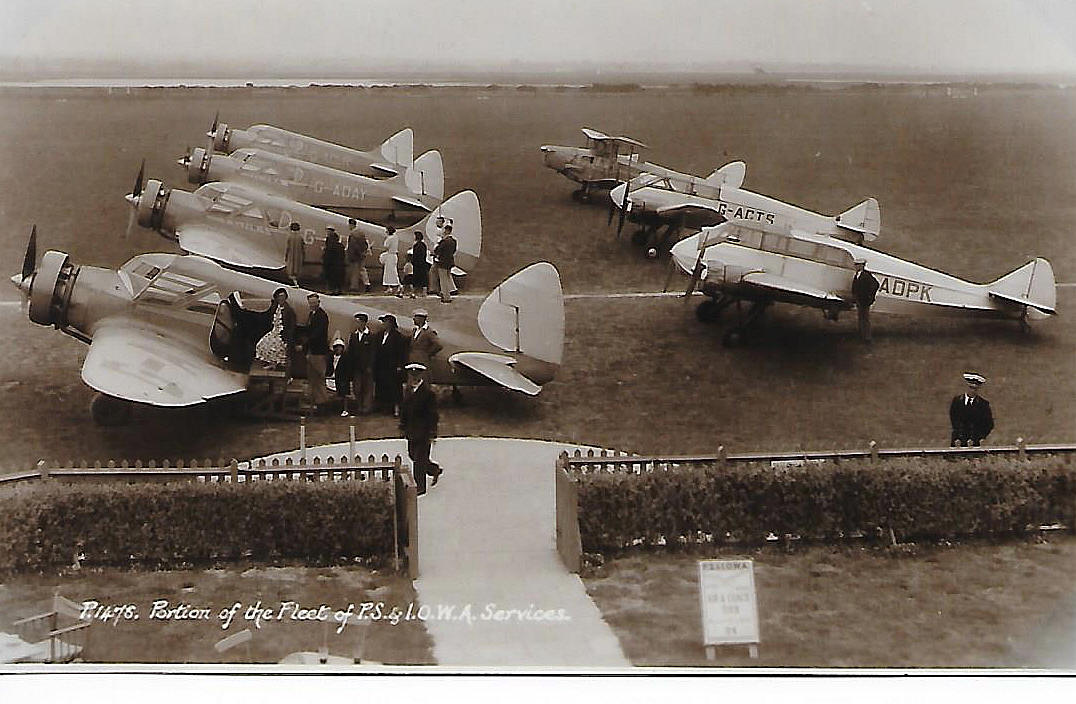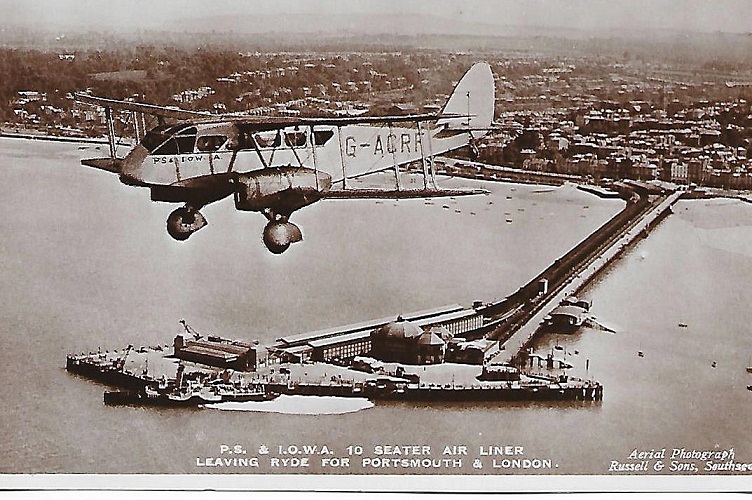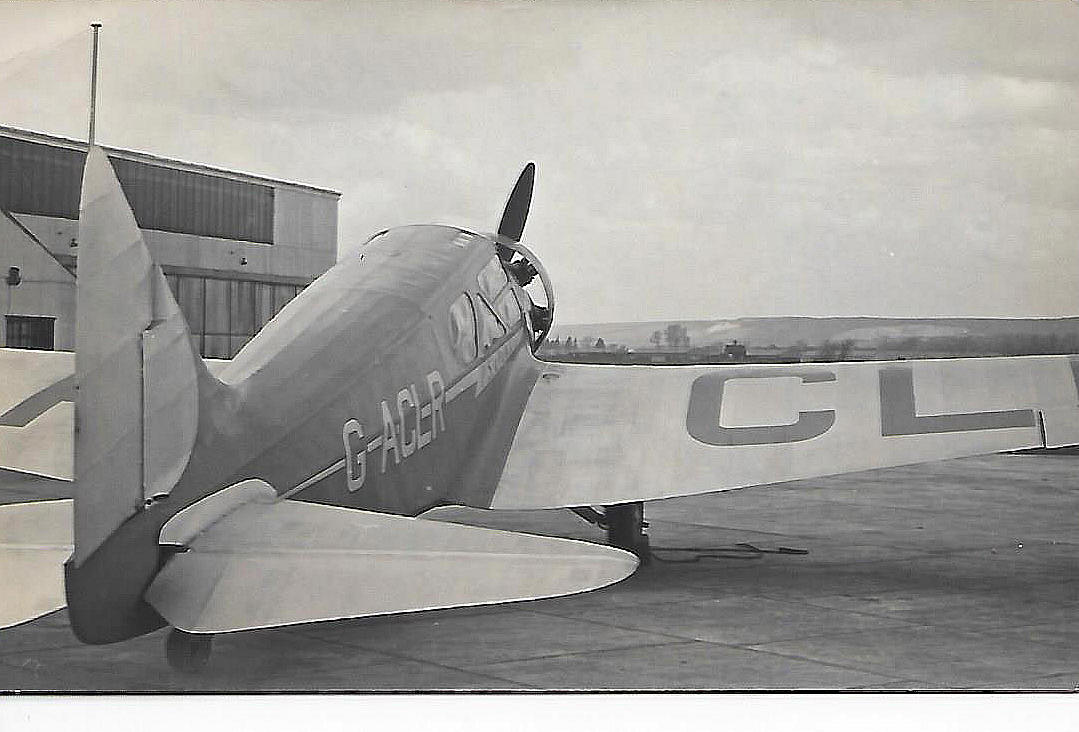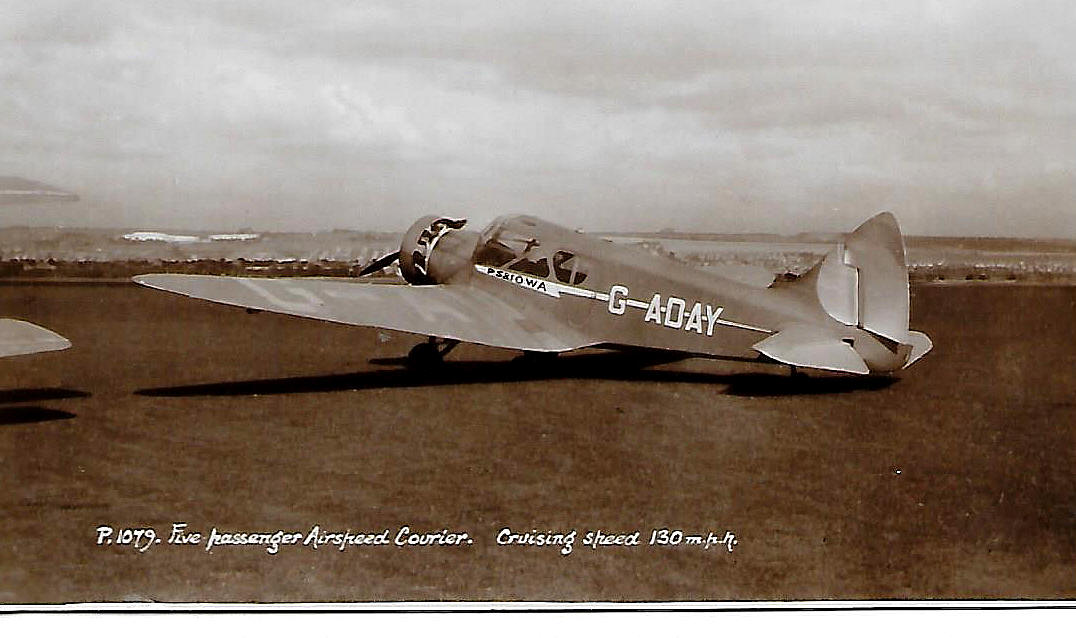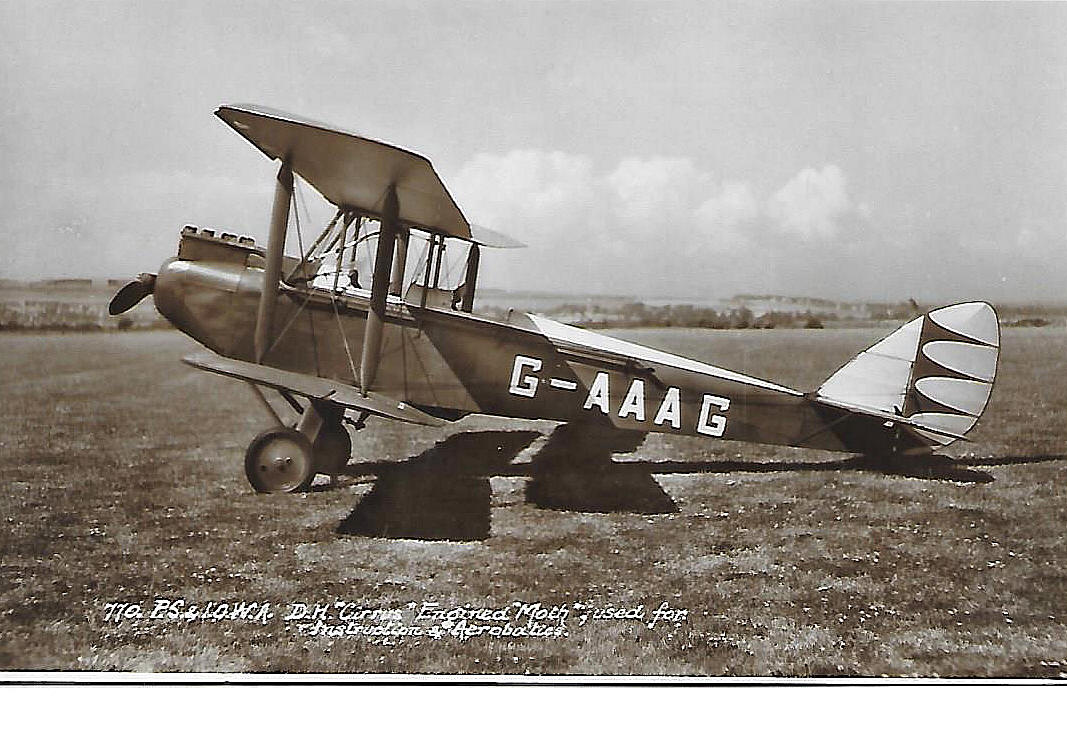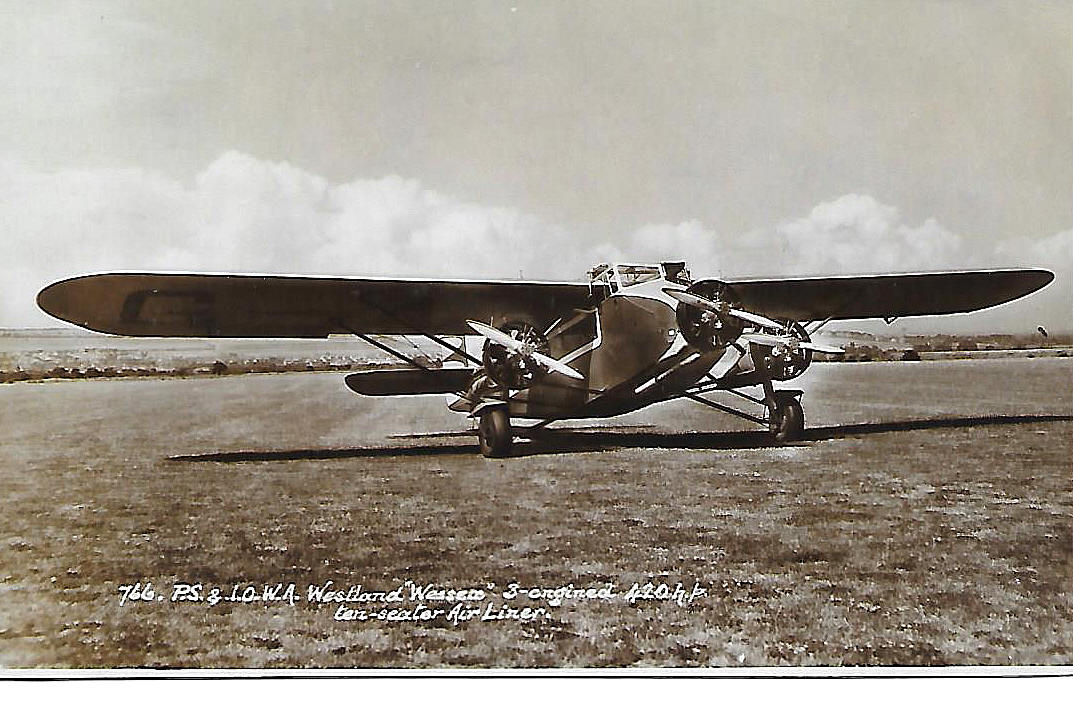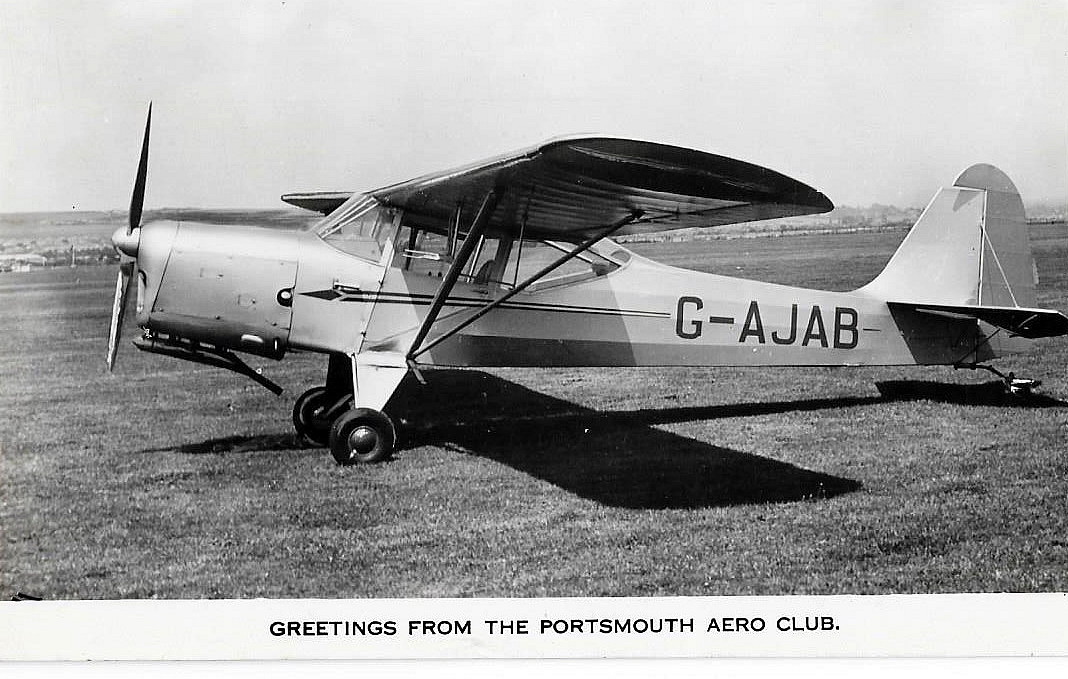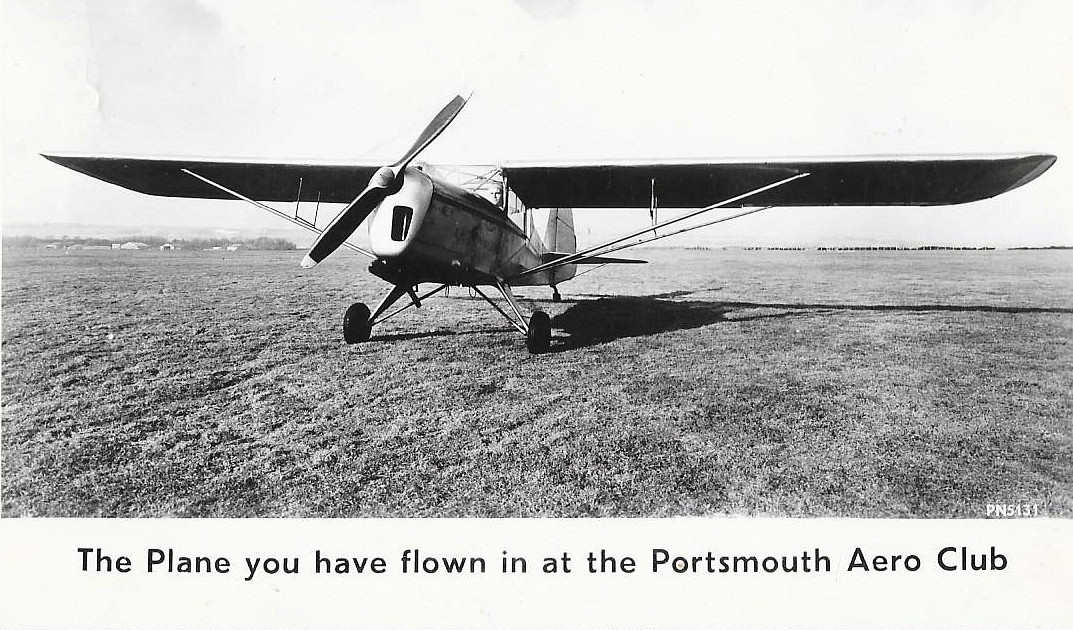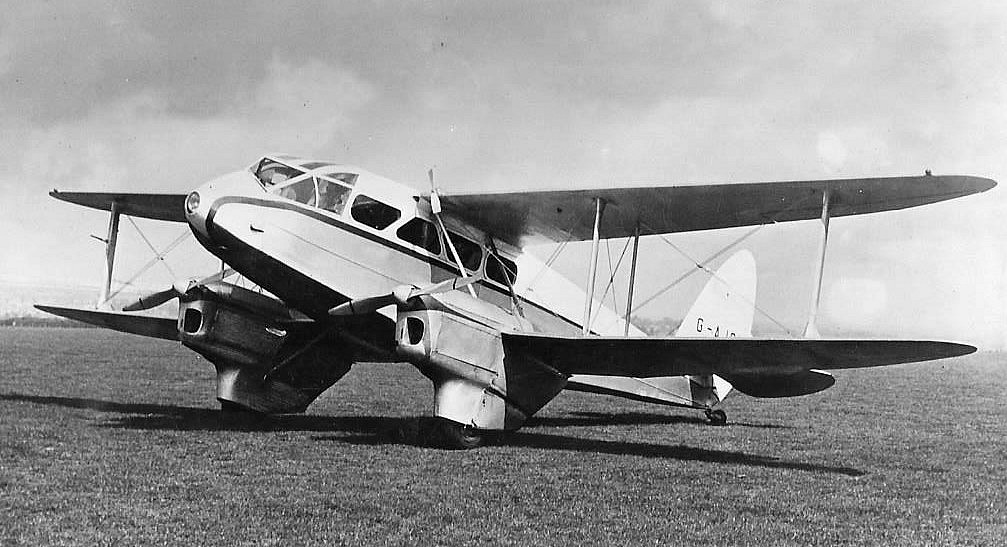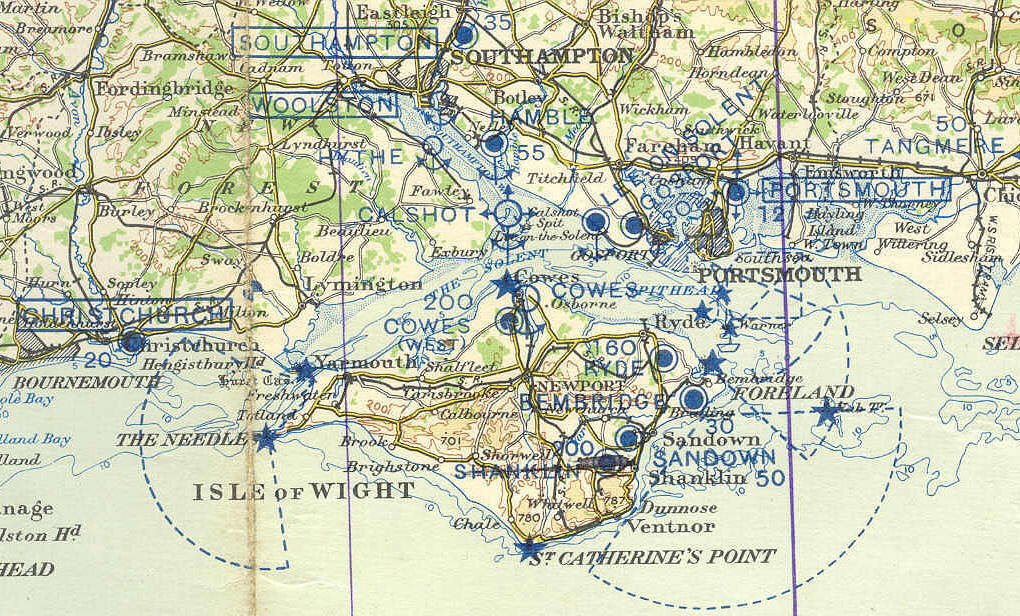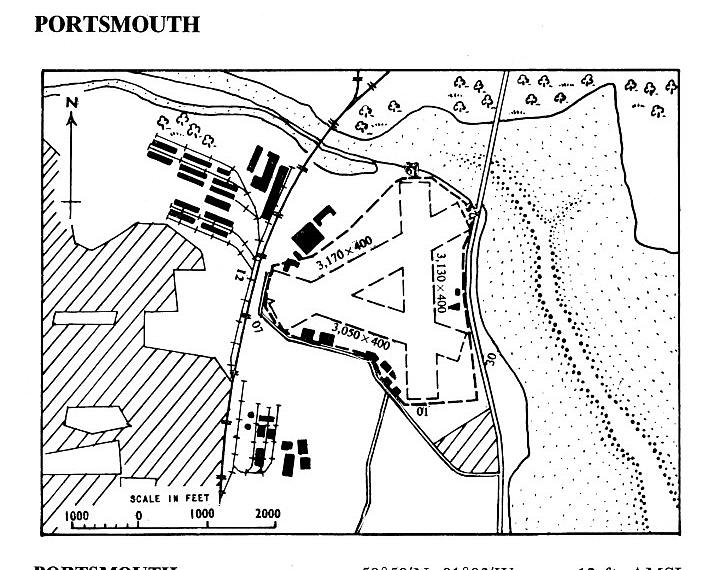Portsmouth Airport
PORTSMOUTH: Civil regional airport (Previously Municipal Aerodrome? Also known as HILSEA?)
A MICHAEL T HOLDER GALLERY
Note: Mike Holder who is a great friend of this 'Guide' has kindly provided the first seven maps and pictures. I have added the Google Earth © area view.
Note: A visit I made to this site in 2011 appeared to reveal nothing that was obviously evidence of the airport ever existing here. Just a couple of road signs.
Third picture: This very amateurish picture is, can you believe, from a postcard and kindly sent by Mike Charlton who has an amazing collection. See, www.aviationpostcard.co.uk
It appears to have been taken from a car speeding past, and, quite why anybody would deem it fit for a postcard seems a complete mystery. But somebody did, and given the paucity of pictures I had found at that stage, I am happy enough to include it here. It is, after all, a historical record of a kind.
Operated by: 1930s through to 1960s: Portsmouth Corporation
Military users: WW2: Apparently used as a satellite airfield for THORNEY ISLAND.
Also possibly used by the US Army Air Corps?
Manufacturing: Portsmouth Aviation, Airspeed factory from 1932
A MIKE CHARLTON GALLERY
Note: These six lovely pictures from postcards were kindly sent by Mike Charlton and feature examples of the PS&OIWA (Portsmouth, Southsea & Isle of Wight Aviation) fleet.
First picture: This shows, on the left, four Airspeed AS.5 Courier types, and on the right two GAL Monospars, and a de Havilland DH83 Fox Moth.
Third in line of the Couriers, G-ADAY, an AS.5 (7 seater), was it seems registered new to PS & IOWA on the 13th April 1935, and served with them until being impressed as X9343 on the 18th March 1940. The fourth in line is the AS.5A Courier (6 seater) G-ACLR. First registered on the 21st November 1933, PS & IOWS didn't acquire it until the 11th August 1936 and was impressed as X9344 on the 18th March 1940.
First in line on the right is the GAL ST-25 Monospar Jubilee G-ADPK, a 5 seater. First registered, (probably new?), on the 9th September 1935, it was impressed as X9348 on the 16th March 1940. Beyond in G-ACTS, a GAL ST-10 Monospar (4 seater) which was first registered on the 3rd July 1934. PS & IOWA acquired it on the 29th November 1937 and it was impressed as X9453 on the 16th April 1940.
I have yet to discover any information about the DH83 Fox Moth seen behind. Can anybody kindly offer advice?
Fifth picture: The de Havilland DH60X Moth, G-AAAG was first registered on the 22nd August 1928, and acquired by PS & IOWA on the 15th January 1930. It crashed into the sea off Spithead on the 1st November 1934.
Sixth picture: The Westland Wessex which I have yet to identify. A ten seater, (like the DH84 Dragon), but with three engines, it makes me wonder what duties, and to where, this aircraft was used? Any advice will be most welcome.
THE PORTSMOUTH, SOUHSEA & ISLE of WIGHT AVIATION FLEET
Note: This is only a list of the fleet details I have found so far. Also, perhaps oddly, I have not been able to find the date that PS & OIWA started operations. Perhaps a clue is the DH60X Moth G-AAAG being acquired in January 1930?
Airspeed AS.5A Courier G-ACLR (5 seater)
Airspeed AS.5 Courier G-ADAY (7 seater)
Airspeed AS.6A Envoy G-ADCA
de Havilland DH60 Cirrus Moth G-AAAG
de Havilland DH83 Fox Moth ?
de Havilland DH84 Dragon II G-ACRF (11 seater) Sold to Australia Feb. 1936 as VH-EXG
GAL ST.10 Monospar G-ACTS (4 seater)
GAL ST.25 Monospar G-ADPK (5 seater)
Westland Wessex ?
British airline users: Pre 1940: Air Dispatch, Cobham Air Routes, Inland Flying Services Ltd*, International Air Lines Ltd**, Jersey Airways Ltd, Portsmouth, Southsea & Isle of Wight Aviation Ltd, Western Air Express, Wight Aviation Ltd
Note: I was interested to discover that from the 20th July 1939 until the 18th April 1940, Portsmouth, Southsea & Isle of Wight Aviation had decided to acquire the Airspeed AS.4 Ferry G-ABSI. Originally specified by Alan Cobham as a STOL 'airliner' for his 'Tours' throughout the UK, it continued in this role with at least one other 'flying circus' operater, C.W.A. Scott, until being acquired by Air Publicity based at HESTON from the 18th November 1936 until the 27th September 1938.
It was then impressed into military service with the RAF on the 18th April 1940 as AV968. Remarkably, perhaps, it survived long enough in the RAF, (who usually crashed and trashed civilian impressed aircraft - let alone their own in large numbers without even being on hostile operations), and it became an instructional airframe - 2758M.
Post 1945: Air Enterprises, Channel Airways, East Anglian Flying Services, JF Airlines
ANOTHER MIKE CHARLTON GALLERY
FOUR PICTURES OF PORTSMOUTH AERO CLUB AIRCRAFT: These pictures from postcards were also kindly sent by Mike Charlton.
First picture: In all the years I have been researching our aviation history, I very much doubt I have found a more complex history of owners as that applying to the Auster 5 J/1 Autocrat G-AJAB, which it seems was later modified to be a J/1N Alpha. For a start it appears it was never registered to Portsmouth Aero Club, but to Southern Flying Schools (SFS). Presumably there was a pretty close relationship here. This said, first registered on the 4th February 1947, ownership by Southern Flying Schools was initially from the 1st September 1952 to the 23rd of October 1952.
It then came back to SFS from the 28th December 1952 until the 28th July 1954. I was interested to note that it went to Britten-Norman on the Isle of Wight from the 1st September 1954 until the 28th April 1955. Coming back to SFS from the 28th April 1955 until the 30th November 1955. The final period in SFS ownership appears to be from the 21st April 1956 until the 30th March 1957.
Fourth picture: The caption was, "Greetings from the Portsmouth Aero Club" and Mike Charlton tells me it was stamped G-AJSL on the back. So, as one does, I decided to look up its history - and what a history it had! A history which seems to tell us a lot about the very unstable state of so much of the civil aviation industry in the post war period. And, I think, worth telling to illustrate this.
G-AJSL started life, as a DH89A Dominie, presumably in the RAF (?) as NR713 and was first registered to Field Aviation Services on the 8th May 1947 until the 16th June 1947, when it was sold abroad. That deal appears to have gone pear-shaped for some reason, as it was re-registered to Field Aviation Services from the 17th January 1948 until the 14th of September 1949. I wonder what they did with it during this period?
It then went to Trent Valley Aviation at TOLLERTON (NOTTINGHAMSHIRE) from the 29th September 1949 until the 1st September 1950. Eagle Aviation then acquired G-AJSL, and operated it from the 8th September 1950 until the 24th December 1951. Can anybody kindly offer advice about what services it operated? It then went to Air Charter at CROYDON from the 24th December 1951 until the 7th April 1952 before passing onto Surrey Flying Services also at CROYDON from the 10th April 1952 until the 22nd March 1956.
From CROYDON J-AJSL then went to PORTSMOUTH initially to Southern Flying Schools from the 26th March 1956 until the 3rd January 1961, and then, on the 10th January 1961 to the Portsmouth Aero Club, who operated it until the 22nd March 1962. So, perseverance has paid off! And, of course, a fairly precise period can be attributed to when this picture was taken.
But, the story of G-AJSN didn't end there. Oh no. It then went to Mr Thomas Hutton Marshall at CHRISTCHURCH (HAMPSHIRE) from the 9th May 1962 until the 28th August 1962, when it was acquired by P E Palmer Holdings, and possibly still based at CHRISTCHURCH or perhaps HURN? It was then registered to Shackleton Aviation from the 2nd May 1963 to the 22nd September 1964. Then going to Airgeeners at STAVERTON, (GLOUCESTERSHIRE) from the 5th October 1964 until the 16th September 1966.
It was then operated, from the 18th October 1966 until the 31st March 1968 by the The Parachute Regiment Free Fall Club. Based where? And finally it went back to Trent Valley Aviation at EAST MIDLANDS AIRPORT, but, was it based here?
The end of G-AJSN appears in doubt. One record states it was PWFU, (Permanently Withdrawn From Use) on the 17th December 1970. Whereas another record states it was WFU (Withdrawn From Use) at USWORTH in January 1971, and shipped to Australia. For an aircraft with such a complex service history, I suppose this is fitting? Any advice will of course be most welcome.
Flying club: Pre 1940: Portsmouth Aero Club, Yapton Aero Club
Post 1945: Portsmouth Aero Club, Portsmouth Flying Schools
Note: In the 1957 The Aeroplane directory, Portsmouth Aero Club were listed as operating three de Havilland DH82A Tiger Moths, five Austers, one Miles M65 Gemini and one de Havilland DH89A Dragon Rapide. Quite a substantial fleet in those days.
1959 ‘snapshot’. Portsmouth Aero Club
Location: Just W of the A2030, about 2.5nm NE of Portsmouth town centre
Period of operation: 1929 (officially opened in March 1932 as the Municipal Aerodrome) to 1973
Note: This map is reproduced with the kind permission of Pooleys Flight Equipment. Copyright Robert Pooley 2014
Runways: Originally ‘all over’ grass field (?), later perhaps with designated grass runways:
07/25 1041x122 grass 12/30 954x79 grass 18/36 1061x106 grass
An airfield map published by Ian Allan ‘British Airports’ in 1959 clearly shows PORTSMOUTH had three runways:
04/22 869x91 grass 07/25 823x91 grass 12/30 792x91 grass
1965: 01/19 954x91 grass 07/25 997x91 grass 12/30 960x91 grass
NOTES: The venue on the 10th August 1932 for Sir Alan Cobham’s National Aviation Day UK Display Tour is ‘Municipal Aerodrome, Portsmouth’. The next year on the 19th August Cobham’s 1933 No.1 Tour displayed in/near Portsmouth, also at the ‘Municipal Aerodrome’?
COMPLEX HISTORY
*This is how the history can become so incredibly complicated. Portsmouth, Southsea & Isle of Wight Aviation evolved from Inland Flying Services based at MAYLANDS (ROMFORD) in ESSEX in 1929. They then moved to APSE MANOR on the ISLE of WIGHT in 1930 and soon became Wight Aviation before moving to PORTSMOUTH in 1932 to become Portsmouth, Southsea & Isle of Wight Aviation.
It appears possible that the first commercial airline service to use this airport was Portsmouth, Southsea & Isle of Wight Aviation using the Westland Wessex G-ABVB, the first service being on the 27th June 1932 to RYDE (ISLE of WIGHT). There are claims, probably justified (?), that this was the shortest (about 15nm?) regular airline route operated in the UK – unless you exclude Scotland of course.
**The brief existence of International Air Lines operating into here from the 24th August 1933 with two Monospar ST.4s G-ABVN and G-ACJF, then ceasing operations about ten days later, seems to demand some sort of explanation? The route flown was CROYDON – PORTSMOUTH – EASTLEIGH (Southampton) and ROBOROUGH (Plymouth).
FLIGHT REFUELLING
Flight Refuelling Ltd was initially formed here according to Ron Smith in British Built Aircraft Vol.3 by Sir Alan Cobham on the 29th October 1934. “….carrying out experiments from Portsmouth using a DH.9 (from 1932-33) and an Airspeed Courier G-ABXN (in 1934) as receiver aircraft. The tanker aircraft were the Handley Page W.10, G-EBMM and G-EBMR.” The company then moved to FORD (SUSSEX) in January 1936.
But what is not mentioned is the amazing flight which was intended to reach Karachi non-stop. Once again I can highly recommend reading the whole story from A Time to Fly by Sir Alan Cobham. Without any doubt they could have succeeded using an Airspeed Courier adapted for the mission. Earlier test flights proved that in-flight refuelling was indeed possible. The orginal idea was to fly to Australia non-stop, but Karachi, then in India was decided to be more realistic and backed by Sir Hugh Dowding at the Air Ministry.
They took off from PORTSMOUTH early on the 22nd September 1934 and topped up their tanks as planned. "Then we flew by dead-reckoning to Marseilles and on to Malta, where we contacted our second W.10 and took on 130 gallons of fuel without difficulty, also food and water and a two-gallon can of oil. Everything looked perfect: we were plainly starting a new chapter in aviation."
"But then something happened that turned out to be a major set-back for refuelling in flight. As I turned to fly on from Malta I found that the throttle lever was loose in my hand: I could move it backwards and forwards without any effect, I had no control whatever over the engine. I turned back at once. We had about 3,000 feet of altitude in hand and the engine was still turning, but we slowly lost power, and I soon found myself gliding in, with the prospect of landing in some very small stone-walled field. This would be difficult at any time, and it now occurred to me that we had an overload on board and that any kind of crash-landing would be followed by fire and probably explosion."
"But by stretching the glide to the utmost, I just managed to scrape in at Halfar aerodrome. 'Scrape' is the right word. The Courier was the first production aircraft to have a retractable undercarriage, (My note: In the UK), and I had not lowered this because I didn't want to increase the drag and shorten the glide: a belly-landing would not do too much harm, since the wheels protruded slightly even when retracted. What scraped the aerodrome surface was the propeller, which was shattered."
"Some R.A.F. people came running up, and we opened the cowling and examined the engine. A cotter pin that held the throttle linkage together had fallen out; there it was, in the tray of the engine cowling. It should have been held in place by a split pin, but some fluff in the hole made it clear that this had never been inserted at all. It was a criminal oversight, and neither the works inspectors nor the A.I.D. had noticed it. The hair-raising thing was that the cotter pin might have fallen out at any point of our flight, so that we had been on the brink of disaster, quite unknowingly, ever since leaving Portsmouth that morning."
A GREAT AIR RACE
In 1936 the Schlesinger Portsmouth to Johannesburg (South Africa) air race took place, starting here. It was intended to rival the MacRoberston England to Australia but for some reason the wealthy South African industrialist Isaac Schlesinger restricted entrants to being British pilots flying British aircraft so in the end only thirteen aircraft were entered, nine aircraft lining up on the 29th September.
These were:
Airspeed Envoy G-AENA British Aircraft Eagle G-ADID British Aircraft Double Eagle G-AEIN
Miles Sparrow Hawk G-AELT Miles Hawk Speed Six G-ADOD Percival Mew Gulls ZS-AHM & ZS-AHO
Percival Vega Gulls G-AEAB & G-AEKE
The Vega Gull G-AEKE was the winning aircraft, flown by Charles W A Scott and Giles Guthrie.
AIR DISPATCH
It also appears that Air Dispatch, based at CROYDON, for some obscure reason which goes against common sense, decided to open, in November 1936, a CROYDON, PORTSMOUTH, SOUTHAMPTON, CHRISTCHURCH and TEIGNMOUTH (Torquay) service. Presumably the latter being HALDON? The service didn't last long of course, but it seems the return fare from CROYDON to CHRISTCHURCH was £3-30-0.
AIRSPEED
Airspeed is perhaps certainly a contender for the “Most Underated British Aircraft Manufacturer” awards? However, the illustrious Sir Alan Cobham supported and believed in the abilities of this company, largely foresaking his strong connections with de Havilland. As proof of his belief in Airspeeds abilities they produced the remarkable AS.4 Ferry, (at their factory in York), a sightseeing airliner type with remarkable short-field capabilities and a very strong contender in the “Ugliest Airliner Ever Built” stakes, a heavily contested title in the between wars period.
It seems the next type, the single-engine AS.5 Courier, which first flew here in April 1933 was essentially a design to accommodate Cobham’s requirements for a non-stop air-frefuelled attempt to reach India. The Courier produced for this flight crash landed on Malta due to a broken throttle linkage. Perhaps the design was too advanced for commercial success (?), as it was the first aircraft produced in any quantity with a retractable undercarriage, but with only 16 being built. As we now know this trend to sometimes produce advanced types, “way ahead of their time”, and after WW2 especially, had bedevilled the British civil aircraft industry. Think Saunders-Roe Princess, the DH.106 Comet, Bristol Britannia, Hawker-Siddeley Trident, Vickers VC.10 and last but certainly not least – Concorde of course. All of these, to some large part surely, helped to bring about its demise?
THE ENVOY
The twin-engine Airspeed AS.6 Envoy, first flown on the 26th June 1934 fared much better, 60 being built. However, the ‘star turn’ for this company was the AS.10 Oxford, first flown on the 19th June 1937. The Oxford was later built elsewhere by De Havilland, Percival and Standard Motors. Altogether 4,411 Oxfords were made.
But, perhaps we shouldn’t get too dewy eyed about the type? The late and lamented Bill Bailey who in his later years was our ‘figurehead’ in the Lion Flying group at ELSTREE trained on the type in Canada during WW2. He told me that if they had a significant flying test/exam and the aircraft didn’t suffer a major failure, (like an engine), they felt like complaining! Of course, and in retrospect, this might have had more to do with inadequately trained and poorly motivated maintenance crews than any inherent faults in the aircraft?
WW2 AND THE LEAD UP
In his excellent biography, Amy Johnson - Enigma in the Sky, author David Luff tells us some interesting aspects: The armed services were not alone in preparing for hostilities; small charter airlines were recruiting extra pilots to fulfil lucrative contracts with the military to conduct army co-operation flights. It usually meant a civilian pilot flying an aircraft on a set course so that anti-aircraft gun batteries could test their accuracy in finding the range and height of an enemy machine. Night flying, for which these pilots were paid a bonus, was also carried out for the benefit of army searchlight crews to practice beaming in on enemy raiders."
"One airline which became engaged in this work was Portsmouth, Southsea & IOW Aviation Ltd, a small company with a dozen or so aircraft which was known to locals as the 'Pip, Aqueak & Wilfred outfit, after the well known cartoon characters in the national press at that time. The company was recruiting extra pilots for the military work and Amy seized the opportunity to get back into flying. She joined the aircraft in June." (My note; this would be in 1939). "She was not the only woman pilot to be employed by them, for at the same time they recruited Joy Davison, a young woman who had been giving pleasure flights using her own DH Moth from a field on Hayling Island. Both women were eventually to join the Air Transport Auxiliary and ultimately to share the same fate."
"For the next three months Amy was quite satisfied to be earning £1 a day, plus another 10 shillings per hour for daylight flying, although it irked her that the night flying, which attracted an extra £1 per hour, was restricted to the male pilots. Apart from the army co-operation work, she was also busy flying holidaymakers in one of the company's four silver, blue and white liveried Airsped Couriers from Portsmouth to Ryde in the Isle of Wight. They were flown right up until the outbreak of war, on what was popularly known as the Spithead Express. Not long after Amy started, the Daily Mail ran an article which read, 'Folks, you've got the chance of being flown by a world-famous pilot for five bob a time.' Passengers were delighted to be flown by someone who was still considered to be a national heroine, and no doubt if she had charged for the many times she was asked for her autograph, she would have added substantially to her income."
"The company also ran a combined air and coach tour of the Isle of Wight, leaving Portsmouth airport at 10.30 a.m. It landed at Ryde to connect its passengers with the 11 a.m. grand tour of the island, from which they returned in time to catch the 6.40 p.m. Courier flight back to the mainland - all for the princely sum of 14s 6d! Some people who took those pre-war trips remembered a well-known national firm of chemists advertising their package for air travellers, which contained chewing gum, smelling salts and a sick bag. They recalled that engines were kept running as passengers hurridly exited the aircraft to allow another batch to board. Seatbelts were conspicious by their absence and on the rare occassions when there were only a few passengers, they would be directed by the pilot to sit exactly where he or she wanted in order not to upset the trim of the aircraft.in flight"
"In spite of the rudimentary comforts of the airline during the seven years in which it operated, it could boast an impressive safety record, carrying 220,000 passengers without death or serious injury."
WAR WAS DECLARED
Here again, David Luff provides more details of interest: "On 31 August 1939, three days before the outbreak of hostilities with Germany, an air navigation restriction order came into force, which meant that all civilian aircraft, apart from some operating with services to the Scottish islands and the Scilly Isles, were grounded and placed at the disposal of the Air Ministry. The aircraft and their civilian pilots from eighteen air companies now came under the control of an organisation known as National Air Communications, with its major base at Cardiff. The commandeered aircraft were speedily repainted with drab camouflage colours and used in a variety of communication flights in which VIPs were flown within the UK and to the continent. Other tasks included carrying freight and running a blood delivery sevice to the British Expeditionary Force in France."
"Amy was directed to report to the airfield at Heston, and await further orders whilst the rest of the personnel working for P S & IOW Aviation were moved on 1 September to Cardiff's municipal aerodrome at Pengham Moors, just 2 miles to the east of the city centre. Such was the air of secrecy that surrounded their move on the morning that they left Portsmouth, that their destination was only revealed when the long, straggling column of vehicles halted at Birdlip Hill." (My note; Birdlip Hill is on the A417, roughly 5nm ESE of Gloucester city centre).
CHANNEL AIRWAYS ETC
In 1959 it was recorded that Channel Airways were operating regular flights to the Channel Islands, the Isle of Wight (SANDOWN?), SHOREHAM and SOUTHEND. The Portsmouth Aero Club were operating two DH Tiger Moths, G-AMHF & G-ANSR. Joyriding was also carried out, (but by whom?), using the DH Dragon Rapide G-AJSI and three Austers, G-AGYM, G-AHCM & G-AJIS.
Although often used by aircraft up to and including Douglas DC-3s, at the later stages even Avro 748s used this grass airport. But, see my ‘runway’ notes re 1959. If these are correct PORTSMOUTH must surely have been marginal at best.
J F AIRLINES
Note: Mike Holder contacted Michael West who took this great picture of G-APHY, and he very kindly agreed that it could be used in this 'Guide'.
Regarding the picture of the Heron, having been sent this picture, I am somewhat concerned that it might be subject to copyright. If this is correct, I will be quite happy to delete it if required; but will very much hope that permission to include it in this 'Guide' will be granted.
I have to thank Mr Gaham Frost, another great friend of this 'Guide' for drawing our attention to this little known airline in January 2021. It certainly deserves a claim to fame as being, (as far as we know?), the only British airline to operate Scottish Aviation Twin Pioneers on commercial airline pasengers services. These were
G-APHX and G-APHY. The routes were to JERSEY with SHOREHAM and HURN, (now BOURNEMOUTH INTERNATIONAL), also served.
The first service appears to have been in June 1971. Some sources say that J.F. stood for 'Jersey Ferry', but others say that 'J.F.' stood for John Fisher, the leading light in the formation of the airline. However, the picture of the DH114 Heron above clearly shows the 'Jersey Ferry' logo.
The airline name was changed to JFA at the end of 1972. It also appears that the Britten-Norman Islander G-AYSS and the Britten-Norman Trislander G-AZZM was operated towards the end.
It would appear that this regional airline was doing rather well, with healthy passenger numbers, and they did seek to find other aerodromes on the south coast they could operate from - but without success. The end came when their main base, PORTSMOUTH closed in 1973.
A MEMORY
In April 2016, my good friend Dave Young and former editor at Truck & Driver magazine sent me this; "A defining recollection of the 1950s is sitting in the garden of my Nan's council house in Drayton listening to the drone of Dragon Rapides circling into Portsmouth airport just to the south."
"Ultimately the failure to upgrade from a grass runway closed it - I was still at school locally when the planes skidded onto the Eastern Road.." Presumably this refers to when Channel Airways Avro 748s were operating?
In May 2019 I was kindly contacted by Brian Burrage. 'The Avro 748 G-ATEK landed at 11.48 on the 15th August 1967 and hit a grass embankment. Then at 13.34 G-ATEH skidded off the runway and ended up straddling Eastern Road.'
Without any doubt this ended Channel Airways involvement at PORTSMOUTH, but continued in operation until the 29th February 1972. Also without much doubt, not having a hard runway hastened the demise of PORTSMOUTH airport, but I doubt that the airport could be expanded enough to allow room for a hard runway long enough to handle larger airliners, such as the Vickers Viscount.
Also, I don't think that these accidents had much if any effect on Avro 748 sales, which was being developed into the ATP. Several examples of which are still flying today. (2019).
Paul Goddard
This comment was written on: 2018-02-20 01:52:36When I was working at GEC on the perimeter of Portsmouth Airport (near Hilsea Halt), Channel Airways was operating DC3 aircraft at the end of the 1950s. These struggled on take-off and landing, barely clearing the perimeter fence. Indeed, there was one of the corporations double-deck busses that appeared to have a tyre mark on it,s white roof, although that may have been an April fool joke that was never painted over; certainly a very good one as it was entirely credible, or, could itreally have happened? by about 1966 the DC3s had been replaced by HS743 aircraft which by comparison were fantastic, clearing the perimeter fence by hundreds of feet rather than the odd twenty-five or so. This went on until the day, towards the end of the decade,when one overrun the airport and ended up straddling the Eastern Road. Worse, a second did the same a couple of hours later. This killed the airport, and fatally damaged both sales of the British-built aircraft and Channel Airways.
Reply from Dick Flute:
Hi Paul, Many thanks indeed. I shall definitely keep this posted. Best regards, Dick
BERNARD RUMBOLD
This comment was written on: 2019-10-04 12:05:57A solitary memory and a tiny bit of history. During the summer of 1960, Iwas an air cadet of 1213 (Andover) Sqn doing a Flying Scholarship at Thruxton. On 25 August I landed Thruxton Jackaroo G-ANFY (a Tiger Moth with 4 seats and a canopy) on the route Thruxton - Shoreham - Portsmouth - Thruxton on my PPL qualifying X-country. Ah! the fun days of my youth!!
Michael Holder
This comment was written on: 2020-05-13 21:50:31There are several good photos of Portsmouth Airport taken in 1932 available on Britain from Above.
We'd love to hear from you, so please scroll down to leave a comment!
Leave a comment ...
Copyright (c) UK Airfield Guide
